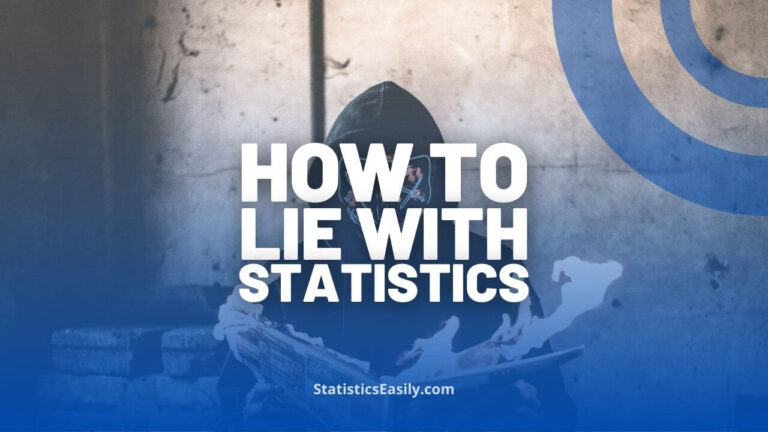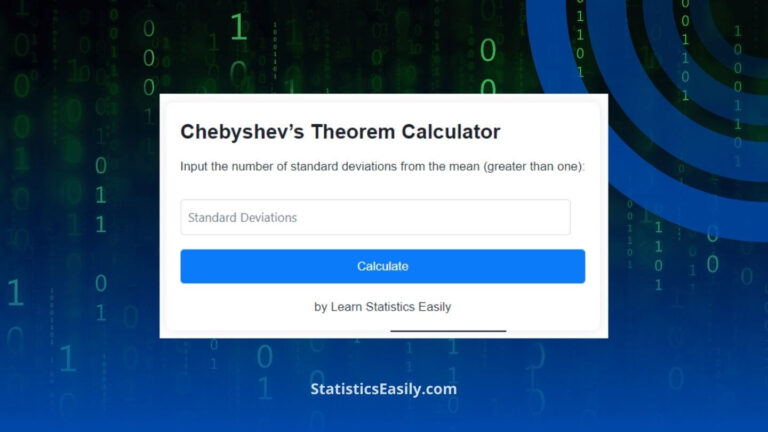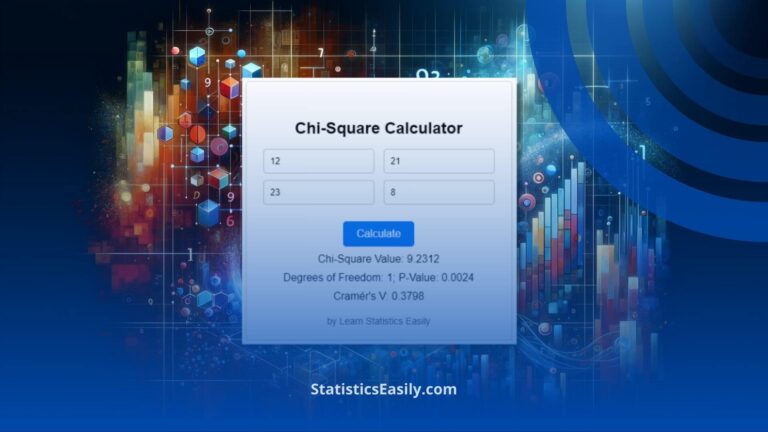Generalized Linear Models Assumptions: A Comprehensive Guide
You will learn the critical role Generalized Linear Models Assumptions play in ensuring the integrity and accuracy of statistical models.
Introduction
Generalized Linear Models (GLMs) are a cornerstone in statistical analysis and data science, extending traditional linear models to accommodate data that deviate from normal distribution assumptions. These models are versatile, enabling the analysis of binary outcomes, count data, and more through a framework that allows for distributions such as Binomial, Poisson, and Gaussian.
Understanding the assumptions of Generalized Linear Models is crucial for their correct application and interpretation. These assumptions ensure that the models can provide accurate, reliable predictions and insights from data. They guide the selection of an appropriate model, the distribution of the response variable, and the link function, laying the groundwork for robust statistical analysis. This foundational knowledge enhances the integrity of research findings and empowers analysts to make informed decisions based on data.
This comprehensive guide delves into the core assumptions underlying GLMs, exploring their significance, implications, and methodologies for validating these assumptions. By grasping these fundamental concepts, researchers and analysts can apply Generalized Linear Models to various data types and research questions, producing valid, reliable, and insightful results that contribute to advancing knowledge across multiple domains.
Highlights
- Assumptions ensure GLMs accurately predict and analyze diverse data types.
- Linearity in parameters is fundamental for GLM reliability and validity.
- Correct distribution choice in GLMs underpins model performance.
- The independence of observations is crucial for GLM assumption validation.
- Addressing overdispersion in GLMs enhances model precision and utility.
Ad Title
Ad description. Lorem ipsum dolor sit amet, consectetur adipiscing elit.
Generalized Linear Models: A Primer
Generalized Linear Models (GLMs) represent a significant extension of linear regression models designed to address data that exhibit non-normal distribution patterns. At their core, GLMs allow the response variable, or dependent variable, to have error distribution models other than a normal distribution. This flexibility makes GLMs indispensable for dealing with various data types encountered in real-world applications.
Basic Concept and Mathematical Foundation
The foundation of GLMs lies in their ability to link the expected value of the response variable to the linear predictors through a link function. This relationship is pivotal as it permits the mean of the response variable to depend on the predictors non-linearly. At the same time, the model itself remains linear in the parameters. Mathematically, a GLM can be expressed as:
g(μ) = β0 + β1X1 + β2X2 + ⋯ + βnXn
where μ is the expected value of the response variable, g() is the link function, β0, β1, ⋯, βn are the coefficients, and X1, X2, ⋯, Xn are the predictors.
Types of Generalized Linear Models and Their Applications
GLMs encompass a wide range of models, each suited to specific types of data and analysis needs:
Linear Regression: The most basic form of regression used for continuous outcomes. It assumes a linear relationship between the dependent and independent variables. It is commonly used in economics, social sciences, and other fields for predicting numerical outcomes.
Logistic Regression: Used for binary outcomes (e.g., success/failure, yes/no). It is commonly applied in fields like medicine for disease presence or absence, marketing for predicting customer churn, and finance for credit risk assessment.
Poisson Regression: Ideal for count data, such as the number of occurrences of an event within a fixed period or space. It finds applications in epidemiology for disease count data, insurance for claim count analysis, and traffic engineering for accident frequency studies.
Multinomial and Ordinal Regression: Extend logistic regression to handle categorical response variables with more than two levels, either unordered (multinomial) or ordered (ordinal).
Negative Binomial Regression: Used for count data similar to Poisson regression but is more suitable for over-dispersed data, where the variance exceeds the mean.
Zero-Inflated Models: These models, such as zero-inflated Poisson and zero-inflated negative binomial, are used when data exceed zero counts, which is common in medical and biological data where events might be rare.
Cox Regression: A survival analysis model used to explore the time for an event to occur. It is widely used in medical research for time-to-event data analysis.
Each GLM type utilizes a specific link function and distribution to model the relationship between the independent variables and the response variable, allowing for a broad application across various disciplines. For instance, logistic regression uses the logit link function and the Binomial distribution. In contrast, Poisson regression employs the natural log link function and the Poisson distribution.
Through the adept application of GLMs, analysts and researchers can uncover significant insights from data that defy the constraints of traditional linear regression, providing a more accurate and nuanced understanding of complex phenomena.
Core Assumptions of Generalized Linear Models
The practical application and interpretation of Generalized Linear Models (GLMs) rest on a nuanced set of core assumptions. These assumptions are pivotal for ensuring the model’s integrity and the reliability of its conclusions. Data analysts and researchers must understand and validate these assumptions, bearing in mind that their applicability and relevance can vary depending on the specific distribution and link function employed in the model. Not all assumptions are uniformly applied across all types of GLMs.
Linearity in Parameters
The assumption of linearity in parameters within Generalized Linear Models (GLMs) entails that the relationship between the predictors and the transformed expectation of the response variable, as mediated by the link function, is linear. This linear relationship is crucial for the interpretability and computational feasibility of GLMs. It’s important to note that the transformation applied by the link function varies with the distribution of the response variable and is not limited to logarithmic transformations, encompassing a range of functions such as logit for binary outcomes and identity for continuous outcomes.
Distribution of the Response Variable (Link Function)
GLMs offer the flexibility to model a diverse range of response variable distributions, including but not limited to normal, binomial, and Poisson distributions. The selection of both the distribution and the corresponding link function must be judiciously aligned with the intrinsic characteristics of the response variable to ensure model accuracy. An inappropriate choice can lead to model misspecification, affecting the validity and reliability of the model’s inferences.
Independence of Observations
The independence assumption dictates that each observation’s response should be independent of the others. This independence is foundational for the reliability of statistical inference within GLMs, as dependency among observations can significantly compromise the model’s statistical conclusions by leading to underestimated standard errors and inflated test statistics.
Adequacy of the Model Size
(Overdispersion and Underdispersion Considerations)
In GLMs, particularly in models like Poisson regression used for count data, overdispersion, and underdispersion are critical considerations. Overdispersion, indicated by observed variance surpassing the model’s expected variance, often signals unaccounted-for variability or the omission of relevant covariates. Underdispersion, though less common, presents a similar challenge to model adequacy. These discrepancies between observed and expected variances may necessitate a reevaluation of the model, potentially leading to the exploration of alternative distributions or the application of variance adjustment methods.
No Multicollinearity Among Predictors
Multicollinearity occurs when predictor variables are highly correlated, potentially distorting the estimation of regression coefficients. While some correlation is expected, excessive multicollinearity may require addressing through variable selection or regularization methods to ensure the model’s stability and interpretability.
Correct Specification of the Model
Ensuring the correct specification of a GLM is fundamental to its success. This involves accurately defining the relationship between the predictors and the response variable, selecting appropriate predictors, and determining the link function’s correct form and the response variable’s distribution. Mis-specification of the model can result in biased estimates and misleading inferences, highlighting the importance of thorough model validation.
Absence of Outliers and High Leverage Points
GLMs, like all statistical models, can be sensitive to outliers and high leverage points that can unduly influence the model’s fit and predictions. It is essential to investigate and potentially mitigate the impact of such data points to ensure the robustness of the model’s conclusions.
Homogeneity of Variances (Homoscedasticity)
The assumption of homogeneity of variances, or homoscedasticity, traditionally significant in linear regression models, is not central in many GLM applications. This is because GLMs inherently accommodate variance modeling as a function of the mean, as exemplified in count models like Poisson regression. However, in contexts where GLMs are applied to continuous response variables with an identity link function, ensuring homoscedasticity becomes relevant. In such cases, it’s advisable to assess the constancy of variance across the range of fitted values to ensure the model’s appropriateness and the reliability of its parameter estimates.
Note: Each assumption has a specific relationship with the chosen distribution and link function, underscoring the importance of a tailored approach to assumption validation in GLMs. Not every assumption is relevant for every GLM variant, and the specific characteristics of the data and model dictate which assumptions need careful consideration and validation.
Diagnostic Tools and Techniques
Ensuring the reliability and validity of Generalized Linear Models (GLMs) necessitates validating their core assumptions. A suite of diagnostic tools and techniques is available, each tailored to address specific facets of the GLM framework. Employing these diagnostics aids in identifying potential model issues and facilitating necessary refinements to bolster model efficacy.
Residual Analysis
- Residual Plots: Plotting residuals against fitted values or predictors unveils non-linearity, heteroscedasticity, and outliers. Deviance or Pearson residuals, chosen based on the response variable’s distribution, are standard in GLMs.
- Normal Q-Q Plots: Q-Q plots effectively assess normality for GLMs with normally distributed residuals. For models with other distributions, it’s crucial to adapt this approach by comparing standardized residuals to the theoretical quantiles of the specific expected residual distribution, enhancing the assessment’s relevance.
Influence Measures
- Leverage Statistics: These statistics spotlight observations that disproportionately sway parameter estimates, attributed to their outlier status in the predictor space. High leverage points necessitate scrutiny for their potential to skew model fit.
- Cook’s Distance: This metric gauges the impact of individual observations on fitted values. Observations marked by high Cook’s distance demand further examination for their pronounced influence on the model.
Multicollinearity Diagnostics
- Variance Inflation Factor (VIF): VIF elucidates the extent to which multicollinearity inflates the variance of estimated regression coefficients. VIFs surpassing 5-10 signal potential multicollinearity concerns, though these thresholds may vary with context.
Overdispersion and Underdispersion Assessment
- Dispersion Statistics: This ratio of residual deviance to degrees of freedom discerns overdispersion (values > 1) from underdispersion (values < 1), pivotal in count data models like Poisson or negative binomial.
- Score Tests: Invaluable for count data models, these tests ascertain the distribution assumption’s fit, aiding in the detection of overdispersion.
Model Specification Tests
- Link Function Check: Graphical techniques, such as contrasting observed versus predicted responses or utilizing CPR plots, scrutinize the link function’s suitability.
- Hosmer-Lemeshow Test: This logistic regression test assesses the goodness of fit by contrasting observed with expected frequencies. While valuable, it’s important to note its limitations, particularly in models with large sample sizes where the test may have reduced sensitivity to detect a lack of fit.
Homogeneity of Variances (Homoscedasticity)
- Scale-Location Plots: These plots assess homoscedasticity by examining the spread of standardized residuals against fitted values. This diagnostic is particularly pertinent for GLMs with a continuous response variable and an identity link function. The interpretation of these plots in GLMs should be nuanced, considering the model’s specific distribution and link function.
Additional Tests
- Durbin-Watson Test: For ordered data, this test assesses autocorrelation in residuals, ensuring the independence assumption’s integrity.
- Akaike Information Criterion (AIC) and Bayesian Information Criterion (BIC): These metrics facilitate model selection, juxtaposing multiple models’ fit and complexity to discern the most suitable.
- Wald Test: This test evaluates the significance of individual model coefficients, informing the predictive value of each predictor.
Additional Clarifications
- Context-Dependent Interpretation: Diagnostic tests, such as VIF for multicollinearity or dispersion statistics for overdispersion, should be context-dependent. Thresholds and critical values might vary based on the specific application, underlying data characteristics, and model complexity.
- Comprehensive Model Evaluation: Highlight the importance of a holistic approach to model diagnostics. No single test can definitively validate all model assumptions or identify all potential issues. A combination of diagnostics, expert judgment, and domain knowledge is essential for thoroughly evaluating the model’s validity and reliability.
The application of these diagnostics hinges on the specific GLM, the data’s characteristics, and the analytical context. A synergistic approach to these tools enables a comprehensive validation process, assuring the GLM is aptly specified and equipped to yield precise, insightful inferences.
Case Studies and Applications
The practical application of Generalized Linear Models (GLMs) spans various fields, demonstrating their versatility and the critical role of adhering to GLM assumptions for accurate and reliable outcomes.
Biology: Understanding Species Distribution
In biology, GLMs have been pivotal in modeling the distribution of species about environmental factors. For instance, a Poisson regression GLM was used to analyze the count data of a particular species across different habitats, with environmental variables as predictors. The model’s adherence to the assumption of independence among observations was crucial, as spatial autocorrelation could lead to inflated significance levels. Proper model specification, accounting for overdispersion using a negative binomial distribution, ensured the robustness of the findings, revealing significant insights into the species’ habitat preferences.
Economics: Analyzing Consumer Behavior
In the economic sector, logistic regression GLMs have been instrumental in predicting consumer behavior, such as the likelihood of purchasing a product based on various demographic factors. The linearity in parameters assumption was carefully validated using link function checks, ensuring that the log purchase odds were linearly related to the predictors. This careful validation led to accurate predictions that informed targeted marketing strategies.
Public Health: Disease Prevalence Studies
GLMs, particularly logistic regression, have been widely used in public health to study the prevalence of diseases. A study examining the risk factors for a disease utilized a logistic GLM, where the correct specification of the model and the link function were paramount. They ensured that no multicollinearity among predictors allowed for a clear interpretation of the impact of individual risk factors. The model’s findings significantly contributed to public health policies by identifying high-risk groups and informing preventive measures.
Environmental Science: Air Quality Analysis
Poisson regression GLMs have been applied to analyze air quality data, precisely the number of days with poor air quality in urban areas. Adherence to GLM assumptions, such as the correct distribution of the response variable and the independence of observations, was essential. Addressing potential overdispersion through dispersion statistics ensured the model’s accuracy, which provided valuable insights into the environmental factors affecting air quality.

Common Pitfalls and How to Avoid Them
In applying Generalized Linear Models (GLMs), practitioners may encounter certain misconceptions and errors that can compromise the effectiveness and validity of the models. Recognizing and addressing these pitfalls is essential for the successful use of GLMs.
Misconceptions and Errors:
- Overlooking the Importance of Distribution Choice: Choosing the wrong distribution for the response variable is a common mistake that can significantly bias the results. Best Practice: It’s crucial to match the distribution to the nature of the response variable, ensuring that the model accurately reflects the data’s characteristics.
- Ignoring Model Assumptions: GLMs rely on specific assumptions, including the parameters’ linearity and the observations’ independence. Overlooking these can lead to incorrect conclusions. Best Practice: Use diagnostic tools like residual analysis and influence measures to verify that these assumptions hold.
- Misinterpreting the Linearity Assumption: There’s a common misunderstanding that the linearity assumption implies a linear relationship between predictors and the response variable. It relates to the linearity in the link function’s scale. Best Practice: Employ graphical methods, such as component-plus-residual plots, to check for linearity concerning the link function.
- Overlooking Overdispersion in Count Models: Failing to account for overdispersion in models like Poisson regression can underestimate the standard errors of the estimates. Best Practice: Check for overdispersion using dispersion statistics and consider using models like negative binomial regression if overdispersion is detected.
- Failure to Address Multicollinearity: High correlation among predictors can lead to inflated variances of coefficient estimates, destabilizing the model. Best Practice: Evaluate multicollinearity through the Variance Inflation Factor (VIF). Consider strategies like dimensionality reduction or regularization to mitigate its effects.
Validation and Assumption Testing:
- Residual Analysis: Employ residual plots and Q-Q plots regularly to check the model’s fit and the residuals’ distribution.
- Influence Diagnostics: Utilize leverage statistics and Cook’s distance to identify and evaluate the impact of influential data points.
Additional Considerations:
- Assumption of Independence: Emphasize the critical nature of the independence assumption, particularly in time-series or spatial data, where autocorrelation might be present.
- Homogeneity of Variances (Homoscedasticity): Although not a central assumption in all GLM applications, verifying homoscedasticity is relevant for models like Gaussian with an identity link.
Ad Title
Ad description. Lorem ipsum dolor sit amet, consectetur adipiscing elit.
Conclusion
In summarizing this guide on Generalized Linear Models (GLMs) and their assumptions, it’s crucial to highlight these assumptions’ significant role in data analysis. Through exploring GLMs, we’ve seen their complexity and adaptability across various fields, emphasizing the necessity of adhering to core assumptions like linearity in parameters, appropriate distribution selection, and observation independence to ensure model integrity and accuracy. This journey also illuminated common pitfalls, such as overlooking distribution choice and misinterpreting linearity, underscoring the need for meticulous validation and application of these models. As we forge ahead, let this guide inspire us to rigorously apply and validate GLM assumptions, enhancing our research’s quality and impact, always guided by the pursuit of truth in our analytical endeavors.
Recommended Articles
Delve deeper into data analysis by exploring more articles on Generalized Linear Models and other statistical techniques on our blog. Empower your data science journey with our curated insights and expert guides.
- Navigating the Basics of Generalized Linear Models: A Comprehensive Introduction
- Generalized Linear Model (GAM) Distribution and Link Function Selection Guide
- Generalized Linear Models in Python: A Comprehensive Guide
- Understanding Distributions of Generalized Linear Models
- The Role of Link Functions in Generalized Linear Models
Frequently Asked Questions (FAQs)
Q1: What Are Generalized Linear Models? GLMs extend linear models to accommodate non-normal distributions, providing a unified framework for various data types.
Q2: Why Are Assumptions Important in GLMs? Assumptions ensure the model’s validity, accuracy, and applicability to real-world data, guiding proper model selection and interpretation.
Q3: What is Linearity in Parameters? It refers to the expectation that the response variable’s change is linearly related to the predictors in GLMs.
Q4: How Does the Link Function Affect GLMs? The link function connects the linear predictor to the mean of the distribution function, ensuring model suitability to the response variable’s nature.
Q5: What is the Role of Distribution in GLMs? The proper distribution for the response variable is critical in GLMs to accurately reflect the data’s underlying structure.
Q6: Why is the Independence of Observations Vital? GLMs assume each data point contributes independently to the likelihood, essential for unbiased parameter estimation.
Q7: How Can Overdispersion Affect GLMs? Overdispersion occurs when observed variance exceeds the model’s expected variance, indicating a potential model misfit or need for adjustment.
Q8: Can GLMs Handle Multicollinearity Among Predictors? While GLMs can be robust, multicollinearity can still inflate variance estimates, making it crucial to assess and mitigate.
Q9: What Diagnostic Tools Are Used in GLMs? Diagnostic tools like residual and influence plots help assess assumptions and identify model fit issues.
Q10: How Are GLMs Applied in Real-World Scenarios? GLMs are versatile and used in fields like epidemiology, finance, and environmental science to model binary outcomes, count data, and more.








